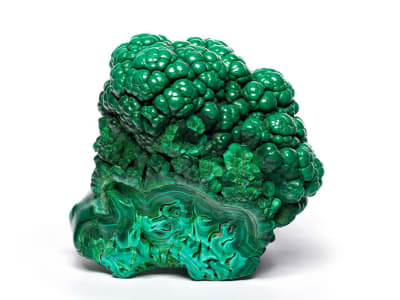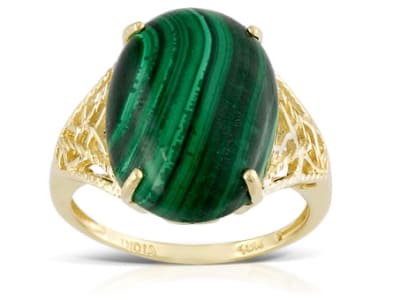Malachite is generally opaque and comes in a vivid bluish green to green color. It is usually banded in two or more tones of green and may have a subtle sheen. This gem is a secondary copper mineral and is commonly found in conjunction with azurite, a bold blue copper carbonate mineral. A mix of the two minerals is often called azurmalachite.
General Information
LWUV: inert
Malachite Colors
-
 Green
Green
Countries of Origin
Tanzania, United Republic Of; Russian Federation; United States of America; Zambia; Congo; Bolivia (Plurinational State of); Canada; Austria; Unknown; China; Ireland; Namibia; Congo (the Democratic Republic of the); Italy; Mexico; South Africa; Zimbabwe; Israel; Australia; France; Germany
History
4,000 years ago, malachite was mined in Egypt and Israel for copper smelting to produce weapons and tools. It was also mined for sculptural and decorative use. The large deposits in the Ural Mountains supplied material for gemstones and sculptural objects in the 1800’s. Malachite was used as eye paint by the ancient Egyptian’s. Malachites use as a paint pigment dates to the 7th century in Japanese and Chinese paintings. It was used in European Renaissance paintings but fell out of favor until the 19th century. Malachite works well for fresco and egg tempera painting, but it tends to be too pale when finely ground for use in oil paints.
Care
Malachite is worn best at your ears and your neckline. It measures at 3 ½ - 4 on the Mohs scale of hardness. Bracelets and rings are best worn with care. Exercise care in cleaning, too. No harsh chemicals or ultrasonic cleaners. Wipe with a soft damp cloth and dry thoroughly. Malachite is soluable in acid.
More About Malachite
In ancient times it was believed that malachite could prevent falling and protect travelers. In some regions of Italy, malachite was believed to protect against the evil eye. Closely related is the belief that, if hung on a baby's bed, malachite could protect the child from evil and bring tranquil sleep. It was also believed that parents who held malachite in the palms of their hands would enjoy restful sleep. Malachite was also thought to attract financial success. After all, it's very green. We enjoy the many folkloric beliefs around oh-so-green malachite. Please remember that there is no scientific evidence of fact in folklore.


